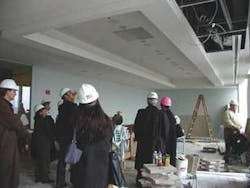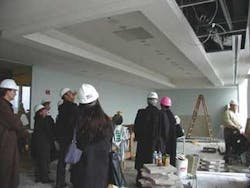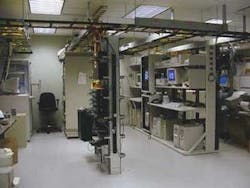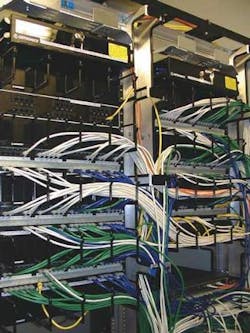In many ways, selecting a Category 6 cabling infrastructure was the easy part for Foley Hoag, LLP (www.foleyhoag.com), a law firm that occupies seven floors and 230,000 square feet of space at 155 Seaport Boulevard—one of the newest addresses in Boston, MA. Even though decisions about the cabling project were being made in early 2000, nearly a year-and-a-half before the Telecommunications Industry Association (TIA) made Category 6 specifications official, issues such as network layout and connectivity with a satellite office posed challenges that rivaled choosing the cabling system's performance level.
null
155 Seaport Boulevard is part of the World Trade Center complex on South Boston's waterfront. The construction of "World Trade Center West," as it is called, was completed in 2002. The 17-story building accompanies World Trade Center East, a 16-story building constructed in 2000, and the 16-story Seaport Hotel, which opened in 1998, making up the complex.
For Frank Bayley, Foley Hoag's director of information technology, the May 2002 move to the new building was the culmination of many months' work. It was also a new opportunity to manage a network and cabling system that was designed into the building structure. He recalls the firm's
20-year history at its former address in the city's Post Office Square. "In 1981, Foley Hoag occupied three floors at 1 Post Office Square. That grew to seven floors and 170,000 square feet before the move," says Bayley. "The first network was installed in the old building in 1991, and at that time, we had to settle for the space that was available to house the networking equipment."
Bayley continues, "At 1 Post Office Square, the distances of many of the cabling runs were close to the maximum allowed, and we had some performance concerns that were attributable to that distance issue. When designing the system here in the new building, we had the opportunity to decide where the telecom rooms would be. Those rooms are stacked horizontally on the floors that we occupy, and even the longest cabling run doesn't approach the maximum allowable distance."
Bayley was part of the space committee, which included the firm's directors and partners, working with the building's architects to ensure that both visual appeal and practicality were given consideration during the design phase. "The tide certainly had shifted in the nine years between the first network installation and the planning of this move," Bayley says. "The firm's managers understand the necessity and benefits of a robust network. While office real estate in Boston is expensive, sacrificing the proper telecommunications rooms was not part of the answer. This part of the planning stage, and its implementation, will pay dividends for years to come."
It would be unfair, though, to say that the entire construction process revolved around the needs of networking and cabling. While much of the office space includes dropped ceilings and modular furniture, easily accessible to cabling professionals and network-management personnel, some areas include hard-ceiling and hard-walled space.
"The fixed ceiling could have been a problem," Bayley notes. "All of the utilities were vying for the same space, from HVAC to plumbing to electrical power to telecommunications."
null
The communications cabling runs through 4-inch conduit in these areas. "It was especially important to make sure that the fixed-ceiling spaces had all the cabling they will need because, ideally, you don't want to access those ceilings after the cabling is initially installed," explains Joe Bodio, president of LAN-Tel Communications (www.lan-tel.com), the project's installation contractor.
Wired for expansion
Overall, Bayley says, he intended to plan for growth by "overcabling" the facility. "If you don't design the space for expansion, you'll never recapture that space in the future. We were cramped in the past and we didn't want that situation repeated in the new facility."
He points to the 30 conference rooms, which have enough cabling to accommodate one out of every three seats, as examples of this strategy. The infrastructure allows secure login for visitors to the firm, as well as network access for all of the firm's users, through outlets built into the tabletops.
Foley Hoag also has 12 Integrated Services Digital Network (ISDN) circuits. LAN-Tel's Phil Milan explains, "By simply patching the ISDN circuits in the data center, you can bring videoconferencing to any of the 30 conference rooms." That fact creates a competitive advantage for Foley Hoag, according to Bayley. The firm has a satellite office in Washington, DC, and the firm's international client base is growing. The combination of modem, data, and voice lines in the conference rooms helps accommodate the demands of long-distance (including overseas) communication.
Cat 6 early adopter
Regarding the selection of Category 6 as the cabling system's performance level, Foley Hoag made that decision in January 2000 based on its present and anticipated future data loads. Voluminous documents, including Portable Document Format (PDF) files, constantly travel electronically among attorneys in the firm and across the Internet to the outside world. A federal district court mandate will soon require that all documents, which sometimes are 150 pages in length, be submitted electronically. All indications are that the amount of data traveling over the firm's network will steadily increase in the years ahead.
"All our connections are 100 Mbits/sec now, and I wonder if there is some bottlenecking at the switches," Bayley says. "We installed the 100-Mbit switches knowing that we would be moving them, and realistically expected to get three to five years out of the switches. I always believed that Category 5e cabling would have about a three- to five-year lifespan, and I use a ten-year window when making upgrade decisions. I will get ten years out of the Category 6 system."
Bayley says a turning point in his decision-making process came when he attended a seminar presented by Mohawk/CDT (www.mohawk-cdt.com) that made the case for Category 6. "We knew there was an uncertainty with Category 6, and at that time there was still industry-wide concern about whether or not it would live up to its billing," says Bayley. "But the thought of wiring this new building with anything less than Category 6, then having to upgrade, was unacceptable given the effort that would go into the project. We knew it was inevitable that Category 6 would be released as a standard, and there was no good reason for not deploying it."
As it turned out, Foley Hoag's move into its office space at 155 Seaport Boulevard, and the activation date of its Category 6 cabling system, occurred almost exactly one week before the TIA cast its final vote of approval for the Category 6 standard. The move took place over Memorial Day Weekend 2002, beginning after the close of business on Friday. By Tuesday at 8 AM, the office and its network were running, with no reports of dead ports or crossed wiring. "LAN-Tel was exceptional to work with, and really rolled with the punches in meeting any of the challenges placed in their path, including the special patching arrangements required for the voice, data, and video," Bayley says.
Vendor selection
With the help of consulting firm Vanderweil Engineers (www.vanderweil.com), Bayley specified a product set for the project. Mohawk/CDT's Category 6+GigaLAN brand UTP cable and Clarity6 connecting hardware from Ortronics (www.ortronics.com) were used throughout the installation. GigaLAN's Flex-Web construction provides pair-to-pair isolation over the entire cable length. The result is superior NEXT and ACR headroom, according to the manufacturer. But Bayley comments that it wasn't just Mohawk's seminar on Category 6 that helped him make that decision. "I have had a great working relationship with Mohawk for over 10 years," he says. "I have attended meetings of Boston-area law-firm IT directors, and all agree that service is a big factor in our satisfaction with vendors. Many people have had difficulty with service, but I haven't."
null
Bayley adds, "I also looked at the warranties of cable vendors. Very few companies offer a 100% warranty on backbone cable. Mohawk does."
Installation contractor LAN-Tel also has an ongoing working relationship with Foley Hoag. LAN-Tel is a Mohawk-Accredited Contractor (MAC) and an Ortronics Certified Installer Plus-Platinum. When the law firm was still at its former site, LAN-Tel built out network expansions as the firm grew. The contractor also installed the audio/video system, and assisted with the telephone-system installation at the new facility. By leaving stock in the Foley Hoag facility, in an emergency, a LAN-Tel installer or technician can be on site within an hour to address moves, adds, and changes, or any other issues. That's a significant statement, which anyone who has ever negotiated Boston traffic can confirm.
Overall, the network at Foley Hoag is prepared for the expansion that the firm expects. "We anticipate 6% to 8% annual growth for the next three to four years," Bayley says. "All drops in the building are live and ready to go, even if no one currently occupies the space. This allows a degree of flexibility for single occupants to work in groups for specific projects."
Bayley and his IT department of 20 provide desktop, network, and training support around the clock. True to the stereotype, the attorneys at Foley Hoag make use of that 24-hour availability. Bayley quips, "At 3 AM, the attorneys outnumber the IT staff in the building."
Patrick McLaughlin is chief editor of Cabling Installation & Maintenance.



